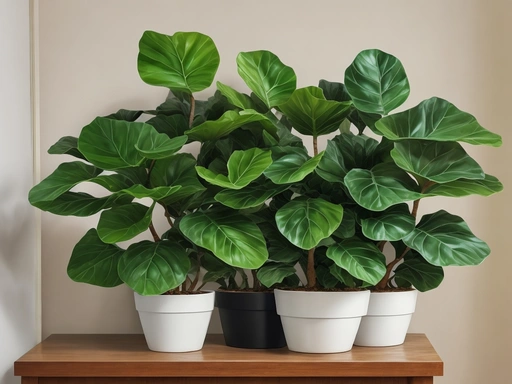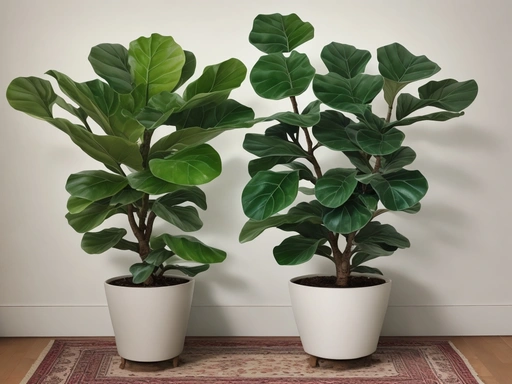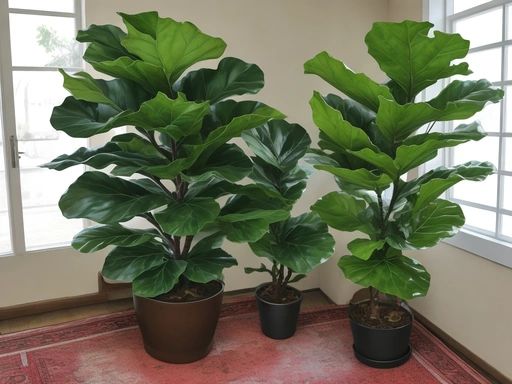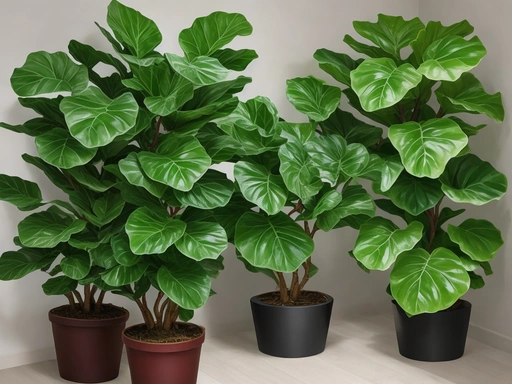DIY Fiddle-Leaf Fig Fertilizer Recipes – Grow Green!
Key Takeaways:
- Use a balanced NPK fertilizer with a ratio of 3:1:2 for optimal fiddle-leaf fig growth.
- Avoid overfertilizing to prevent burning the plant’s roots and causing nutrient imbalances.
- Incorporate organic matter like compost or worm castings to promote soil fertility.
- Consider using a slow-release fertilizer for a convenient and long-lasting nutrient supply.
Are you tired of spending a fortune on commercial fertilizers for your fiddle-leaf fig plant? Well, I’ve got some exciting news for you! DIY fertilizer recipes for fiddle-leaf figs are all the rage right now, and for good reason.
Not only are they cost-effective, but they also give you complete control over the ingredients you put into your plant’s soil.
Plus, you can customize the nutrient balance to meet your specific plant needs. So, if you’re ready to save some money and give your fiddle-leaf figs the love they deserve, keep reading to discover some fantastic DIY fertilizer recipes!
| Recipe | Ingredients | Instructions |
|---|---|---|
| Basic Fertilizer | 1 part worm compost 1 part perlite 1 part peat moss 4 parts water | Mix all ingredients together. Allow the mixture to sit for 24 hours before use. |
| Organic Blend | 2 parts worm castings 1 part fish emulsion 1 part liquid kelp 1 part water | Combine all ingredients and stir well. Apply to the fiddle-leaf fig every 2-4 weeks during the growing season. |
| Nutrient-Rich Mix | Equal parts worm castings and compost 1 part Epsom salt 1 part water | Mix the worm castings, compost, and Epsom salt. Add water gradually until the mixture reaches the desired consistency. |
Benefits of Using DIY Fertilizer for Fiddle-leaf Figs
Using DIY fertilizer for your fiddle-leaf figs has several benefits including cost-effectiveness and control over ingredients.
1. Cost-effectiveness
Using DIY fertilizer for your fiddle-leaf figs can be cost-effective because you can create your own fertilizers using inexpensive ingredients that are easily accessible.
This allows you to save money compared to purchasing commercial fertilizers.
Additionally, DIY fertilizers can be made in small quantities, meaning you only make what you need, minimizing waste and saving you even more money in the long run.

2. Control over Ingredients
Having control over the ingredients in your DIY fertilizer for fiddle-leaf figs allows you to tailor the nutrient content to the specific needs of your plant.
You can choose organic ingredients, adjust the ratios of nutrients like nitrogen, phosphorus, and potassium, and avoid harmful chemicals.
This ensures that your plant gets exactly what it needs to thrive.

3. Customized Nutrient Balance
Customized nutrient balance is crucial for fiddle-leaf figs because it ensures that they receive the right amount of essential nutrients. By understanding their specific nutrient requirements, considering factors like soil pH and composition, and monitoring their response to fertilizer, you can create a fertilizer that meets their needs and promotes healthy growth.
Factors to Consider Before Making DIY Fertilizers
Before making your own DIY fertilizers for your fiddle-leaf fig, there are a few factors you should consider.
1. Understanding Nutrient Requirements
Understanding the nutrient requirements of your fiddle-leaf fig is crucial for creating an effective DIY fertilizer. These plants need a balanced blend of nitrogen, phosphorus, and potassium, with a ratio of approximately 3:1:2.
Additionally, they require trace amounts of micronutrients like iron, manganese, and magnesium.
Regularly testing your soil’s nutrient levels can help you determine the specific needs of your plant.

2. Soil pH and Composition
Soil pH and composition are important factors to consider when making DIY fertilizer for fiddle-leaf figs. A pH level between 6.0 and 7.0 is ideal for these plants.
To determine pH, you can use a soil test kit.
Additionally, the composition of the soil, such as its nutrient content, drainage, and texture, also affects the effectiveness of the fertilizer. Adjusting these factors can help create an optimal environment for your plant to thrive.

3. Watering and Drainage
Proper watering and drainage are crucial for the health of your fiddle-leaf fig. Here are a few tips:
- Water thoroughly but infrequently. Allow the top few inches of soil to dry out before watering again.
- Use well-draining soil to prevent waterlogged roots. Add perlite or sand to improve drainage.
- Choose a pot with drainage holes to allow excess water to escape.
- Avoid overwatering, as it can lead to root rot. Monitor the soil moisture and adjust your watering schedule accordingly.
- Consider using a moisture meter to accurately measure the moisture level in the soil.
Remember, finding the right balance between watering and drainage is essential for the overall health of your fiddle-leaf fig.
4. Fertilizer Application Frequency
The frequency of fertilizing your fiddle-leaf fig plant depends on various factors such as the type of fertilizer used, the plant’s growth stage, and environmental conditions.
As a general guideline, fertilize your fiddle-leaf fig every 2-4 weeks during the growing season (spring and summer), and reduce or stop fertilization during the dormant season (fall and winter).
Monitor your plant’s response to determine the optimal fertilization frequency.
DIY Fertilizer Recipes for Fiddle-leaf Figs
Want to learn how to make your own fertilizer for your fiddle-leaf figs?
Check out these simple DIY recipes!
1. Basic All-Purpose Fertilizer Recipe
For a basic all-purpose fertilizer recipe for fiddle-leaf figs, you can combine equal parts of nitrogen, phosphorus, and potassium.
Nitrogen promotes leaf growth, phosphorus supports root development, and potassium aids in overall plant health.
Mix the ingredients well and apply according to the instructions.
2. Organic Fertilizer Recipe
To make an organic fertilizer for your fiddle-leaf fig, you can use coffee grounds and crushed eggshells.
Simply mix equal parts of coffee grounds and crushed eggshells together.
This mixture provides essential nutrients like nitrogen, calcium, and potassium.
Apply this organic fertilizer to the soil around your plant, avoiding direct contact with the leaves.
3. Liquid Fertilizer Recipe
To make a liquid fertilizer for your fiddle-leaf fig, you can use a few different ingredients. One simple recipe is to mix 1 tablespoon of water-soluble fertilizer with 1 gallon of water.
Another option is to use compost tea by steeping compost in water for a few days, then straining out the solids.
Dilute the compost tea with water before using. Just be sure to follow the instructions on the fertilizer package and avoid over-fertilizing.
4. Slow-Release Granular Fertilizer Recipe
To make a slow-release granular fertilizer for your fiddle-leaf fig, try this simple recipe: Mix together one part bone meal, one part vermiculite or perlite, and one part well-aged compost or worm castings. This blend will provide a slow and steady release of nutrients to nourish your plant over time.
Tips for Applying DIY Fertilizers to Fiddle-leaf Figs
When applying DIY fertilizers to your fiddle-leaf figs, keep these tips in mind for best results.
1. Choosing the Right Concentration
The right concentration of DIY fertilizer for your fiddle-leaf fig depends on the specific needs of your plant. Start with a lower concentration and gradually increase it if needed.
Consider factors like the plant’s size, growth stage, and nutrient requirements.
Regularly monitor your plant’s response to the fertilizer and adjust the concentration accordingly.
2. Applying Fertilizer to Root Zone
To apply fertilizer to the root zone of your fiddle-leaf fig, start by diluting the fertilizer according to the package instructions.
Then, pour the diluted fertilizer directly onto the soil around the base of the plant, avoiding the leaves.
Water the plant thoroughly after applying the fertilizer to help it absorb nutrients.
Be careful not to over-fertilize, as this can harm your plant.
3. Avoiding Overfertilization
To avoid overfertilization of your fiddle-leaf fig, it’s important to follow a few guidelines.
Firstly, always read the instructions on the fertilizer packaging and stick to the recommended dosage.
Secondly, avoid applying fertilizer too frequently, as this can lead to nutrient buildup in the soil.
And thirdly, make sure to monitor your plant’s response to the fertilizer and adjust accordingly.
Remember, less is often more when it comes to fertilizing your fiddle-leaf fig!
4. Monitoring Plant Response
To monitor the response of your fiddle-leaf fig to DIY fertilizer, keep an eye on its overall growth and health. Look for signs of new leaf growth, vibrant green color, and increased fullness.
On the flip side, be alert for any yellowing leaves, wilting, or stunted growth.
These indicators will help you gauge the effectiveness of your fertilizer and make adjustments if needed.
Frequently Asked Questions about Fiddle-leaf Fig Fertilizer
1. How often should I fertilize my fiddle-leaf fig plant?
Fiddle-leaf fig plants should be fertilized every 4-6 weeks during the growing season, which is usually spring and summer. You can reduce the frequency to every 8-12 weeks in the fall and winter when the plant is in a dormant phase.
Remember to adjust the fertilizer amount based on your plant’s specific needs.
2. Can I use regular houseplant fertilizer for my fiddle-leaf fig?
Regular houseplant fertilizers may not be suitable for fiddle-leaf figs because they have specific nutrient requirements.
Fiddle-leaf figs prefer a fertilizer with a balanced ratio of nitrogen, phosphorus, and potassium.
It’s best to use a fertilizer specifically formulated for fiddle-leaf figs or make your own DIY fertilizer to meet their specific needs.
3. Is it better to use liquid or granular fertilizer for fiddle-leaf figs?
Liquid fertilizer is better for fiddle-leaf figs as it is quickly absorbed by the roots, providing immediate nutrition. It also allows for better control over nutrient concentrations.
Granular fertilizer, on the other hand, releases nutrients slowly and may require frequent application.
4. Can I make a DIY fertilizer using kitchen scraps?
Yes, you can make a DIY fertilizer using kitchen scraps.
Kitchen scraps like banana peels, coffee grounds, and eggshells can be composted and used as natural fertilizer for your fiddle-leaf fig.
Simply chop or break them into small pieces, add them to your compost pile or mix them directly into the soil around your plant.
Over time, the scraps will break down and release nutrients that your plant can absorb.
Final Verdict
Making your own DIY fertilizer for your fiddle-leaf fig plants can offer several benefits, including cost-effectiveness, control over ingredients, and the ability to customize the nutrient balance. However, before making DIY fertilizers, it is important to consider factors such as understanding nutrient requirements, soil pH and composition, watering and drainage, and fertilizer application frequency.
Additionally, there are various DIY fertilizer recipes available, including basic all-purpose, organic, liquid, and slow-release granular options.
Finally, applying DIY fertilizers to fiddle-leaf fig plants requires careful consideration of concentration, application to the root zone, avoiding overfertilization, and monitoring plant response. thriving fiddle-leaf fig plants, you can confidently create and apply your own DIY fertilizer for healthy and thriving fiddle-leaf fig plants.







